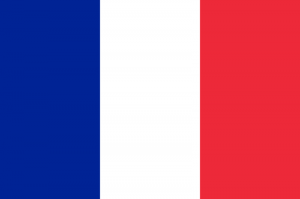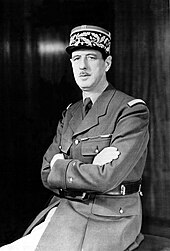France
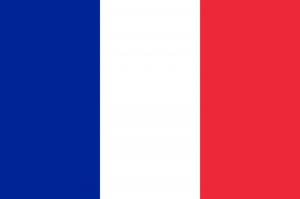
The Rise and Fall of Versailles (Part 1 of 3)
Louis XIV, The Dream of a King – The symbol of France’s glory, Versailles is probably the most splendid royal palace in Europe. From 1643 to 1792 it was the stage on which the most glorious period of the French Monarchy played out. Filmed in Versailles itself, this three-part drama-documentary brings the 150-year reign of France’s three most famous monarchs – Louis XIV, Louis XV and Louis XVI – to life. It includes interviews with the world’s leading specialists. (From France, in English and French) (Documentary Series) (Part 1 of 3) (Hard Coded English Subtitles).
France (UK /ˈfrɑːns/; US ![]() i/ˈfræns/; French: [fʁɑ̃s] (
i/ˈfræns/; French: [fʁɑ̃s] (![]() listen)), officially the French Republic (French: République française [ʁepyblik fʁɑ̃sɛz]), is a sovereign country in Western Europe that includes overseas regions and territories. Metropolitan France extends from the Mediterranean Sea to the English Channel and the North Sea, and from the Rhine to the Atlantic Ocean. It is one of only three countries (besides Morocco and Spain) to have both Atlantic and Mediterranean coastlines. Due to its shape, it is often referred to in French as l’Hexagone (“The Hexagon“).
listen)), officially the French Republic (French: République française [ʁepyblik fʁɑ̃sɛz]), is a sovereign country in Western Europe that includes overseas regions and territories. Metropolitan France extends from the Mediterranean Sea to the English Channel and the North Sea, and from the Rhine to the Atlantic Ocean. It is one of only three countries (besides Morocco and Spain) to have both Atlantic and Mediterranean coastlines. Due to its shape, it is often referred to in French as l’Hexagone (“The Hexagon“).
France is the largest country in Western Europe and the European Union, and the third-largest in Europe as a whole. With a total population of around 66 million, it is the third most-populous European country. France is a unitary semi-presidentialrepublic with its capital in Paris, the nation’s largest city and the main cultural and commercial centre. The current Constitution of France, adopted by referendum on 4 October 1958, establishes the country as secular and democratic, with its sovereignty derived from the people. The nation’s ideals are expressed in the foundational Declaration of the Rights of Man and of the Citizen, one of the world’s earliest documents on human rights, which was formulated during the seminal French Revolution of the late 18th century.
France has been a major power in Europe since the Late Middle Ages, reaching the height of its influence and prestige during the 19th and early 20th centuries, when it possessed the second-largest colonial empire of the time, and one of the largest in history. This legacy is reflected in the prevalence of French language, culture, and jurisprudence worldwide. France has produced many influential artists, thinkers, and scientists, and remains a prominent global centre of culture. Subsequently, its hosts the world’s fourth-largest number of cultural UNESCO World Heritage Sites, drawing around 83 million foreign tourists annually, the most of any country in the world.
France remains a major power with significant cultural, economic, military, andpolitical influence in Europe and around the world. It has the world’s sixth-largest military budget and third-largest stockpile of nuclear weapons, with a diplomatic corps that is second only to the United States. France is a developed country and has the world’s fifth-largest economy by nominal GDP and seventh-largest by purchasing power parity. In terms of total household wealth, France is the wealthiest nation in Europe and fourth in the world.
French citizens enjoy a high standard of living, with the country performing well in international rankings of education, health care, life expectancy, civil liberties, and human development. France is a founding member of the United Nations, where it serves as one of the five permanent members of the UN Security Council. It is a member of numerous international institutions, including Francophonie, the G8,G20, NATO, OECD, WTO, and the Latin Union. France is a founding and leading member state of the European Union.
Etymology – Name of France
The name “France” comes from the Latin Francia, which means “country of the Franks.” There are various theories as to the origin of the name Franks: one is that it is derived from the Proto-Germanic word frankon which translates as javelin or lance as the throwing axe of the Franks was known as a francisca. Another proposed etymology is that in an ancient Germanic language, Frank means free as opposed to slave.
History of France – Prehistory of France
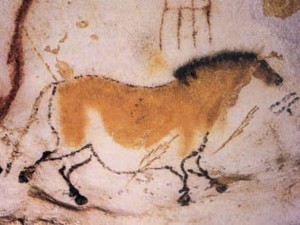 One of the Lascaux paintings of which depicts a horse (Dordogne, approximately 18,000 BC).
One of the Lascaux paintings of which depicts a horse (Dordogne, approximately 18,000 BC).
The oldest traces of human life (homo) in what is now France date from approximately 1.8 million years ago. Humans were then confronted by a hard and variable climate, marked by several glacial eras which led them to a nomadic life of hunter-gatherer. France has a large number of decorated caves from the upper Paleolithic era, including one of the most famous and best preserved: Lascaux (approximately 18,000 BC).
At the end of the last glacial period (10,000 BC), the climate softened and from approximately 7,000 BC, this part of Western Europe entered the Neolithic era and its inhabitants became sedentary. After strong demographic and agricultural development between the 4th and 3rd millennia, metallurgy appeared at the end of the 3rd millennium, initially working gold, copper and bronze, and later iron. France has numerous megalithic sites from the Neolithic period, including the exceptionally dense Carnac stones site (approximately 3,300 BC).
Gaul, Celts, and Roman Gaul
In 600 BC, Ionian Greeks, originating from Phocaea, founded the colony of Massalia (present-day Marseille), on the shores of the Mediterranean Sea. This makes it France’s oldest city. At the same time, some Gallic Celtic tribes penetrated parts of the current territory of France, and this occupation spread to the rest of France between the 5th and 3rd century BC.
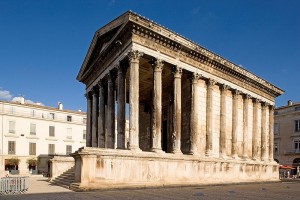 The Maison Carrée was a temple of the Gallo-Roman city of Nemausus (present-day Nîmes) and is one of the best preserved vestiges of the Roman Empire.
The Maison Carrée was a temple of the Gallo-Roman city of Nemausus (present-day Nîmes) and is one of the best preserved vestiges of the Roman Empire.
The concept of Gaul emerged at that time; it corresponds to the territories of Celtic settlement ranging between the Rhine, the Atlantic Ocean, the Pyrenees and the Mediterranean. The borders of modern France are roughly the same as those of ancient Gaul, which was inhabited by Celtic Gauls. Gaul was then a prosperous country, of which the southernmost part was heavily subject to Greek and Roman influences. However, around 390 BC, the Gallic chieftain Brennus and his troops made their way to Italy through the Alps, defeated the Romans in the Battle of the Allia, and besieged and ransomed Rome. The Gallic invasion left Rome weakened and the Gauls continued to harass the region until 345 BC, when they entered into a formal peace treaty with Rome. But the Romans and the Gauls would maintain an adversarial relationship for the next several centuries and the Gauls would remain a threat in Italia.
Around 125 BC, the south of Gaul was conquered by the Romans, who called this regionProvincia Romana (“Roman Province”), which over time evolved into the name Provencein French. Julius Caesar conquered the remainder of Gaul and overcame a revolt carried out by the Gallic chieftain Vercingetorix in 52 BC. Gaul was divided by Augustus into Roman provinces. Many cities were founded during the Gallo-Roman period, including Lugdunum (present-day Lyon), which is considered to be the capital of the Gauls. These cities were built in traditional Roman style, with a forum, a theatre, a circus, an amphitheatre and thermal baths. The Gauls mixed with Roman settlers and eventually adopted Roman speech (Latin, from which the French language evolved) and Roman culture. The Roman polytheism merged with the Gallic paganism into the same syncretism.
From the 250s to the 280s AD, Roman Gaul suffered a serious crisis with its “limes” or fortified borders protecting the Empire being attacked on several occasions by barbarians. Nevertheless, the situation improved in the first half of the 4th century, which was a period of revival and prosperity for Roman Gaul. In 312, the emperor Constantin I converted to Christianity. Christians, persecuted until then, increased rapidly across the entire Roman Empire. But, from the beginning of the 5th century, the Barbarian Invasions resumed, and Germanic tribes, such as the Vandals, Suebi and Alans crossed the Rhine and settled in Gaul, Spain and other parts of the collapsing Roman Empire.
Kingdom of Francia (3rd century–843)
Francia, Merovingian dynasty, and Carolingian dynasty, List of French monarchs and France in the Middle Ages
At the end of the Antiquity period, ancient Gaul was divided into several Germanic kingdoms and a remaining Gallo-Roman territory, known as the Kingdom of Syagrius (West). Simultaneously, Celtic Britons, fleeing the Anglo-Saxon settlement of Britain, settled the western part of Armorica. As a result, the Armorican peninsula was renamed Brittany, Celtic culture was revived and independent petty kingdoms arose in this region.
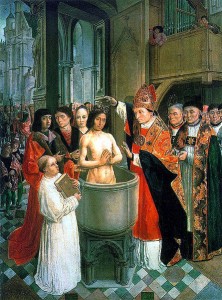 With Clovis‘ conversion to Catholicism in 498, the Frankish monarchy, elective and secular until then, became hereditary and of divine right.
With Clovis‘ conversion to Catholicism in 498, the Frankish monarchy, elective and secular until then, became hereditary and of divine right.
The pagan Franks, from whom the ancient name of “Francie” was derived, originally settled the north part of Gaul, but under Clovis I conquered most of the other kingdoms in northern and central Gaul. In 498, Clovis I was the first Germanic conqueror after the fall of the Roman Empire to convert to Catholic Christianity, rather than Arianism; thus France was given the title “Eldest daughter of the Church” (French: La fille aînée de l’Église) by the papacy, and French kings would be called “the Most Christian Kings of France” (Rex Christianissimus).
The Franks embraced the Christian Gallo-Roman culture and ancient Gaul was eventually renamed Francia (“Land of the Franks”). The Germanic Franks adopted Romanic languages, except in north Gaul where Roman settlements were less dense and where Germanic languages emerged. Clovis made Paris his capital and established the Merovingian dynasty, but his kingdom would not survive his death. The Franks treated land purely as a private possession and divided it among their heirs, so four kingdoms emerged from Clovis’s: Paris, Orléans, Soissons, and Rheims.
The last Merovingian kings lost power to their mayors of the palace (head of household). One mayor of the palace, Charles Martel, defeated an Islamic invasion of Gaul at the Battle of Tours(732) and earned respect and power within the Frankish kingdoms. His son, Pepin the Short, seized the crown of Francia from the weakened Merovingians and founded the Carolingian dynasty. Pepin’s son, Charlemagne, reunited the Frankish kingdoms and built a vast empire across Western and Central Europe.
Proclaimed Holy Roman Emperor by Pope Leo III and thus establishing in earnest the French government’s longtime historical association with the Catholic Church, Charlemagne tried to revive the Western Roman Empire and its cultural grandeur.
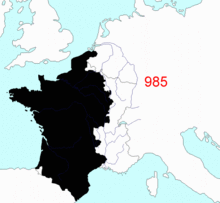 French territorial evolution from 985 to 1947
French territorial evolution from 985 to 1947
Charlemagne’s son, Louis I (emperor 814–840), kept the empire united; however, this Carolingian Empire would not survive his death. In 843, under the Treaty of Verdun, the empire was divided between Louis’ three sons, with East Francia going to Louis the German, Middle Francia to Lothair I, and West Francia to Charles the Bald. West Francia approximated the area occupied by, and was the precursor, to modern France.
During the 9th and 10th centuries, continually threatened by Viking invasions, France became a very decentralised state: the nobility’s titles and lands became hereditary, and the authority of the king became more religious than secular and thus was less effective and constantly challenged by powerful noblemen. Thus was established feudalism in France. Over time, some of the king’s vassals would grow so powerful that they often posed a threat to the king. For example, after the Battle of Hastings in 1066, the William the Conqueror added “King of England” to his titles, becoming both the vassal to (as Duke of Normandy) and the equal of (as king of England) the king of France.
Kingdom of France (843–1791)
Kingdom of France, Capetian dynasty, Valois dynasty, and Bourbon dynasty, List of French monarchs, France in the Middle Ages, Early modern France, and Ancien Régime
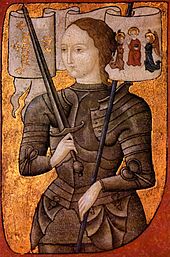 Joan of Arc led the French army to several important victories during the Hundred Years’ War which paved the way for the final victory.
Joan of Arc led the French army to several important victories during the Hundred Years’ War which paved the way for the final victory.
The Carolingian dynasty ruled France until 987, when Hugh Capet, Duke of France and Count of Paris, was crowned King of the Franks. His descendants – the Capetians, the House of Valois, and the House of Bourbon – progressively unified the country through wars and dynastic inheritance into the Kingdom of France, which was fully declared in 1190 by Philip II Augustus. Gerbert d’Aurillac (Gerbert of Aurillac) was the first French pope; his reign as Pope Sylvester II lasted from 999 to 1003.
The Albigensian Crusade was launched in 1209 to eliminate the heretical Cathars in the south-western area of modern-day France. In the end, the Cathars were exterminated and the autonomous County of Toulouse was annexed into the kingdom of France. Later Kings expanded their territory to cover over half of modern continental France, including most of the North, Centre and West of France. Meanwhile, the royal authority became more and more assertive, centred around a hierarchically conceived society distinguishing nobility, clergy, and commoners.
Charles IV the Fair died without an heir in 1328. Under the rules of the Salic law the crown of France could not pass to a woman nor could the line of kingship pass through the female line. Accordingly, the crown passed to Philip of Valois, a cousin of Charles, rather than through the female line to Charles’ nephew, Edward, who would soon become Edward III of England. During the reign of Philip of Valois, the French monarchy reached the height of its medieval power.
However, Philip’s seat on the throne was contested by Edward III of England and in 1337, on the eve of the first wave of the Black Death, England and France went to war in what would become known as the Hundred Years’ War. The exact boundaries changed greatly with time, but French landholdings of the English Kings remained extensive for decades.
With charismatic leaders, such as Joan of Arc and La Hire, strong French counterattacks won back English continental territories. Like the rest of Europe, France was struck by the Black Death. Around 1340, France had a population of approximately 17 million, which by the end of the pandemic had declined by about one-half.
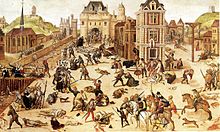 The St. Bartholomew’s Day massacre(1572) was the climax of the French Wars of Religion, which were brought to an end by the Edict of Nantes (1598).
The St. Bartholomew’s Day massacre(1572) was the climax of the French Wars of Religion, which were brought to an end by the Edict of Nantes (1598).
The French Renaissance saw a long set of wars, known as the Italian Wars, between the Kingdom of France and the powerful Holy Roman Empire. It also saw the first standardization of the French language, which would become the official language of France and the language of Europe’s aristocracy. French explorers, such as Jacques Cartier or Samuel de Champlain, claimed lands in the Americas for France, paving the way for the expansion of the First French colonial empire.
The rise of Protestantism in Europe led France to a civil war known as the French Wars of Religion, where, in the most notorious incident, thousands of Huguenots were murdered in the St. Bartholomew’s Day massacre of 1572. The Wars of Religion were ended by Henry IV‘s Edict of Nantes, which granted some freedom of religion to the Huguenots.
Under Louis XIII, the energetic Cardinal Richelieu reinforced the centralization of the state, royal power and French dominance in Europe, foreshadowing the reign of Louis XIV. During Louis XIV’s minority and the regency of Queen Anne and Cardinal Mazarin, a period of trouble known as the Fronde occurred in France, which was at that time at war with Spain. This rebellion was driven by the great feudal lords and sovereign courts as a reaction to the rise of royal power in France.
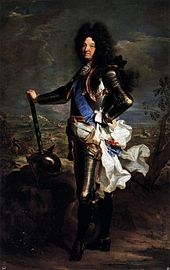 Louis XIV, the “sun king” was the absolute monarch of Franceand made France the leading European power.
Louis XIV, the “sun king” was the absolute monarch of Franceand made France the leading European power.
The monarchy reached its peak during the 17th century and the reign of Louis XIV. By turning powerful feudal lords into courtiers at the Palace of Versailles, Louis XIV’s personal power became unchallenged. Remembered for his numerous wars, he made France the leading European power. France possessed the largest population in Europe (see Demographics of France) and had tremendous influence over European politics, economy, and culture. French became the most-used language in diplomacy, science, literature and international affairs, and remained so until the 20th century. France obtained many overseas possessions in the Americas, Africa and Asia. Louis XIV revoked the Edict of Nantes, forcing thousands of Huguenots into exile.
Under Louis XV, France lost New France and most of its Indian possessions after its defeat in the Seven Years’ War, which ended in 1763. Its continental territory kept growing, however, with notable acquisitions such as Lorraine (1766) and Corsica (1770). An unpopular king, Louis XV’s weak rule, his ill-advised financial, political and military decisions, and his debauchery discredited the monarchy and arguably led to the French Revolution 15 years after his death.
Louis XVI, Louis XV’s grandson, actively supported the Americans, who were seeking their independence from Great Britain (realized in the Treaty of Paris (1783)). The example of the American Revolution and the financial crisis which followed France’s involvement in it were two of many contributing factors to the French Revolution.
Much of the Enlightenment occurred in French intellectual circles, and major scientific breakthroughs and inventions, such as the discovery of oxygen (1778) and the first hot air balloon carrying passengers (1783), were achieved by French scientists. French explorers, such as Bougainville and Lapérouse, took part in the voyages of scientific exploration through maritime expeditions around the globe. The Enlightenment philosophy, in which reason is advocated as the primary source for legitimacy and authority, undermined the power of and support for the monarchy and helped pave the way for the French Revolution.
Republics and Empires (1792–) French Revolution, First French Empire, Second French Empire, and French Colonial Empire, France in the 19th century and France in the 20th century
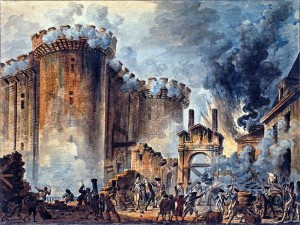 The Storming of the Bastille on 14 July 1789 was the starting event of the French Revolution.
The Storming of the Bastille on 14 July 1789 was the starting event of the French Revolution.
After the storming of the Bastille on 14 July 1789, the absolute monarchy was abolished and France became a constitutional monarchy. Through the Declaration of the Rights of Man and of the Citizen, France established fundamental rights for French citizens (who could only be male). The Declaration affirms “the natural and imprescriptible rights of man” to “liberty, property, security and resistance to oppression”. It called for the destruction of aristocratic privileges and proclaimed freedom and equal rights for all men, as well as access to public office based on talent rather than birth.
The monarchy was restricted, and all citizens were to have the right to take part in the legislative process. Freedom of speech and press were declared, and arbitrary arrests outlawed. The Declaration also asserted the principles of popular sovereignty, in contrast to the divine right of kings that characterized the French monarchy, and social equality among citizens, eliminating the privileges of the nobility and clergy.
While Louis XVI, as a constitutional king, enjoyed popularity among the population, his disastrous flight to Varennes seemed to justify rumours he had tied his hopes of political salvation to the prospects of foreign invasion. His credibility was deeply undermined to the extent that the abolition of the monarchy and establishment of a republic became an increasing possibility.
European monarchies gathered against the new régime, to restore the French absolute monarchy. The foreign threat exacerbated France’s political turmoil and deepened the sense of urgency among the various factions and war was declared against Austria on 20 April 1792. Mob violence occurred during the insurrection of 10 August 1792 and the following month. As a result of this violence and the political instability of the constitutional monarchy, the Republic was proclaimed on 22 September 1792.
Napoleon, Emperor of the French, and his Grande Arméebuilt a vast Empire across Europe. He helped spread the French revolutionary ideals and his legal reforms had a major influence worldwide.
Louis XVI was convicted of treason and guillotined in 1793. Facing increasing pressure from European monarchies, internal guerrilla wars and counterrevolutions (such as the War in the Vendée or the Chouannerie), the young Republic fell into the Reign of Terror. Between 1793 and 1794, between 16,000 and 40,000 people were executed. In Western France, the civil war between the Bleus (“Blues”, supporters of the Revolution) and the Blancs (“Whites”, supporters of the Monarchy) lasted from 1793 to 1796 and led to the loss of between 200,000 and 450,000 lives.
Both foreign armies and French counterrevolutionnaries were crushed and the French Republic survived. Furthermore, it extended greatly its boundaries and established “Sister Republics” in the surrounding countries. As the threat of a foreign invasion receded and France became mostly pacified, the Thermidorian Reaction put an end to Robespierre‘s rule and to the Terror. The abolition of slavery and male universal suffrage, enacted during this radical phase of the revolution, were cancelled by subsequent governments.
After a short-lived governmental scheme, Napoleon Bonaparte seized control of the Republic in 1799 becoming First Consul and later Emperor of the French Empire (1804–1814/1815). As a continuation of the wars sparked by the European monarchies against the French Republic, changing sets of European Coalitions declared wars on Napoleon’s Empire. His armies conquered most of continental Europe, while members of the Bonaparte family were appointed as monarchs in some of the newly established kingdoms.
These victories led to the worldwide expansion of French revolutionary ideals and reforms, such as the Metric system, the Napoleonic Code and the Declaration of the Rights of Man. After the catastrophic Russian campaign, Napoleon was defeated and the Bourbon monarchy restored. About a million Frenchmen died during the Napoleonic Wars.
Douaumont ossuary. With 4.3 million wounded from a population of only 39.6 million at the time, the Third French Republic sustained the highest number of total casualties among the Allies during World War I.
After his brief return from exile, Napoleon was finally defeated in 1815 at the Battle of Waterloo, the monarchy was re-established (1815–1830), with new constitutional limitations. The discredited Bourbon dynasty was overthrown by the July Revolution of 1830, which established the constitutional July Monarchy, which lasted until 1848, when the French Second Republic was proclaimed, in the wake of the European Revolutions of 1848. The abolition of slavery and male universal suffrage, both briefly enacted during the French Revolution were re-enacted in 1848.
In 1852, the president of the French Republic, Louis-Napoléon Bonaparte, Napoleon I’s nephew, was proclaimed emperor of the second Empire, as Napoleon III. He multiplied French interventions abroad, especially in Crimea, in Mexico and Italy. Napoleon III was unseated following defeat in the Franco-Prussian War of 1870 and his regime was replaced by the Third Republic.
France had colonial possessions, in various forms, since the beginning of the 17th century. In the 19th and 20th centuries, its global overseas colonial empire extended greatly and became the second largest in the world behind the British Empire. Including metropolitan France, the total area of land under French sovereignty almost reached 13 million square kilometres in the 1920s and 1930s, 8.6% of the world’s land.
Charles de Gaulle took an active part in all major events of the 20th century: a hero of World War I, leader of the Free French during World War II, he then became President, where he facilitated decolonization, maintained France as a major power and overcame the revolt of May 1968.

